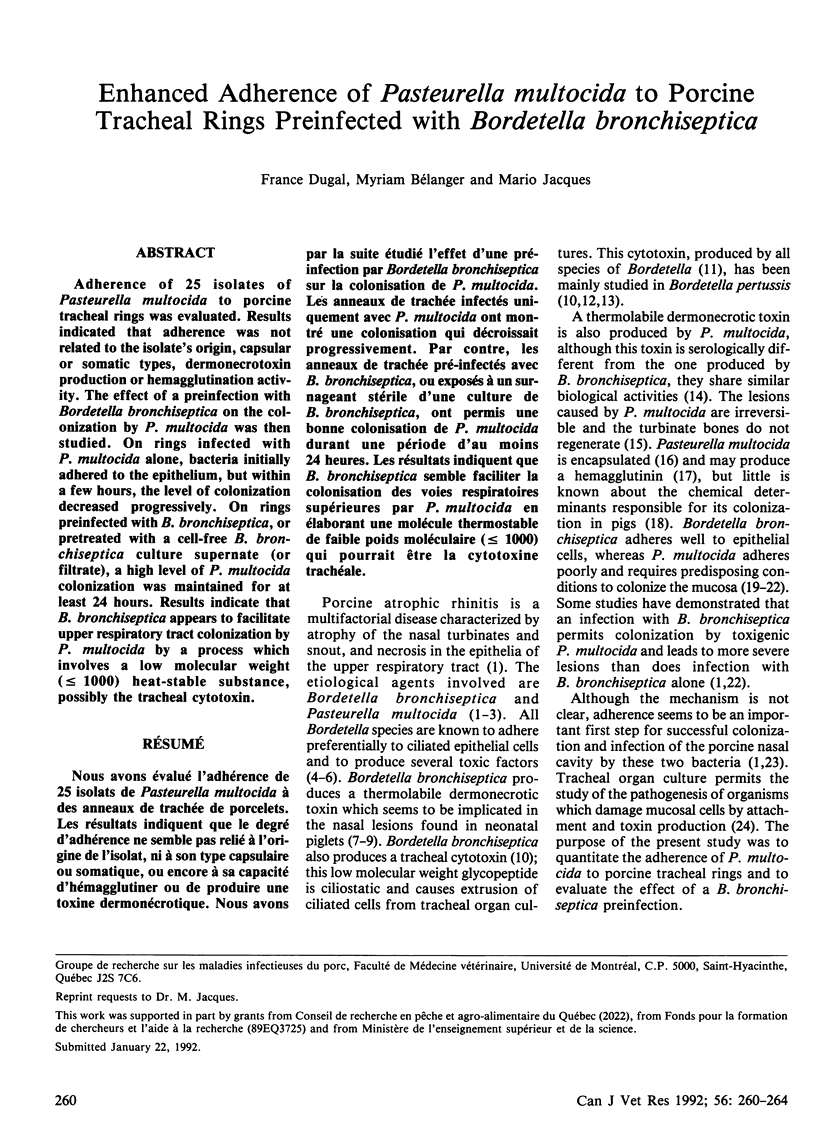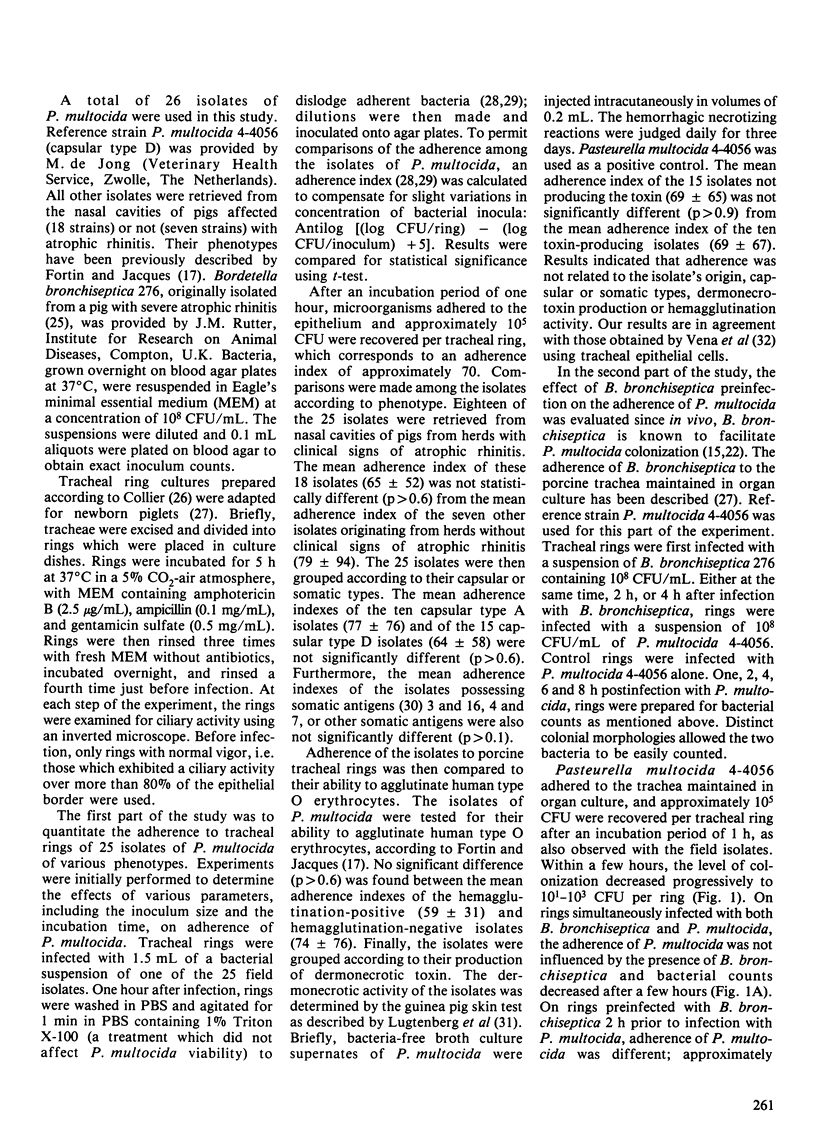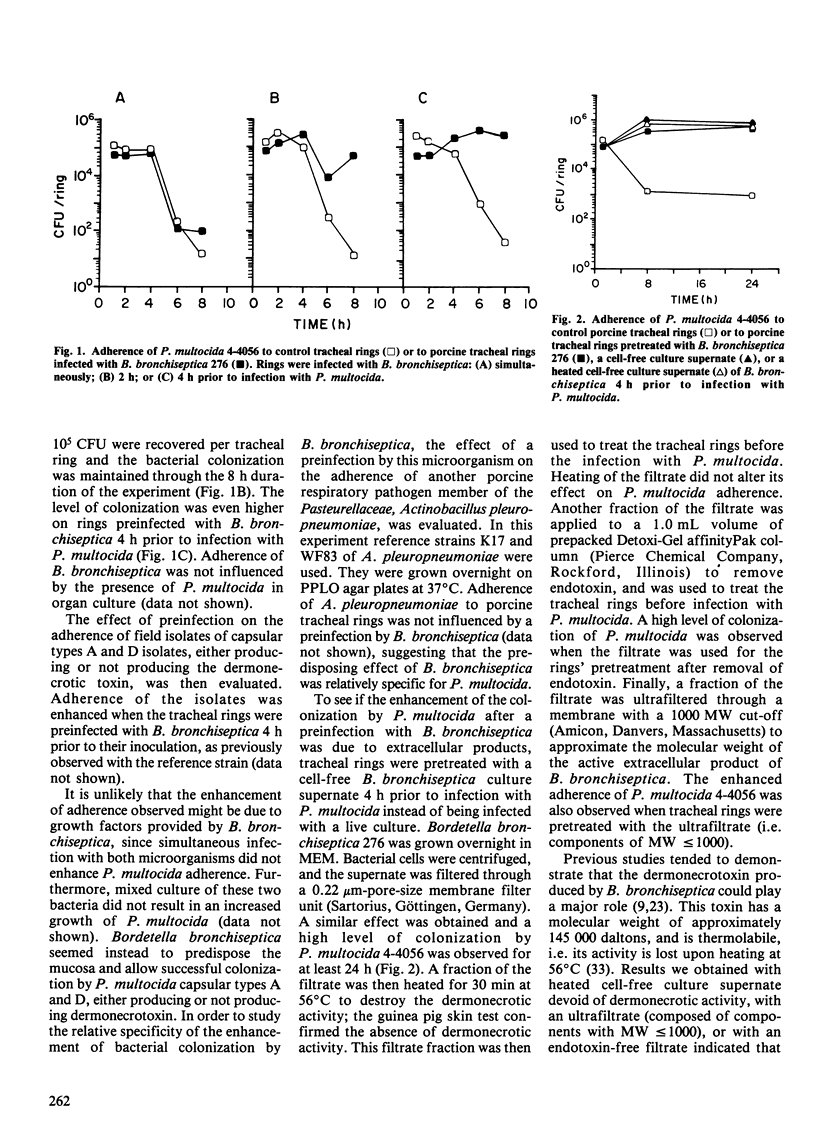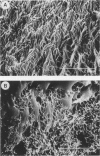Abstract
Adherence of 25 isolates of Pasteurella multocida to porcine tracheal rings was evaluated. Results indicated that adherence was not related to the isolate's origin, capsular or somatic types, dermonecrotoxin production or hemagglutination activity. The effect of a preinfection with Bordetella bronchiseptica on the colonization by P. multocida was then studied. On rings infected with P. multocida alone, bacteria initially adhered to the epithelium, but within a few hours, the level of colonization decreased progressively. On rings preinfected with B. bronchiseptica, or pretreated with a cell-free B. bronchiseptica culture supernate (or filtrate), a high level of P. multocida colonization was maintained for at least 24 hours. Results indicate that B. bronchiseptica appears to facilitate upper respiratory tract colonization by P. multocida by a process which involves a low molecular weight (less than or equal to 1000) heat-stable substance, possibly the tracheal cytotoxin.
Full text
PDF




Images in this article
Selected References
These references are in PubMed. This may not be the complete list of references from this article.
- Arp L. H., Brooks E. E. An in vivo model for the study of Bordetella avium adherence to tracheal mucosa in turkeys. Am J Vet Res. 1986 Dec;47(12):2614–2617. [PubMed] [Google Scholar]
- Bélanger M., Dubreuil D., Harel J., Girard C., Jacques M. Role of lipopolysaccharides in adherence of Actinobacillus pleuropneumoniae to porcine tracheal rings. Infect Immun. 1990 Nov;58(11):3523–3530. doi: 10.1128/iai.58.11.3523-3530.1990. [DOI] [PMC free article] [PubMed] [Google Scholar]
- Chanter N., Magyar T., Rutter J. M. Interactions between Bordetella bronchiseptica and toxigenic Pasteurella multocida in atrophic rhinitis of pigs. Res Vet Sci. 1989 Jul;47(1):48–53. [PubMed] [Google Scholar]
- Cookson B. T., Cho H. L., Herwaldt L. A., Goldman W. E. Biological activities and chemical composition of purified tracheal cytotoxin of Bordetella pertussis. Infect Immun. 1989 Jul;57(7):2223–2229. doi: 10.1128/iai.57.7.2223-2229.1989. [DOI] [PMC free article] [PubMed] [Google Scholar]
- Cookson B. T., Tyler A. N., Goldman W. E. Primary structure of the peptidoglycan-derived tracheal cytotoxin of Bordetella pertussis. Biochemistry. 1989 Feb 21;28(4):1744–1749. doi: 10.1021/bi00430a048. [DOI] [PubMed] [Google Scholar]
- Dugal F., Girard C., Jacques M. Adherence of Bordetella bronchiseptica 276 to porcine trachea maintained in organ culture. Appl Environ Microbiol. 1990 Jun;56(6):1523–1529. doi: 10.1128/aem.56.6.1523-1529.1990. [DOI] [PMC free article] [PubMed] [Google Scholar]
- Fortin M., Jacques M. Hemagglutination by Pasteurella multocida of porcine origin. J Clin Microbiol. 1987 May;25(5):938–939. doi: 10.1128/jcm.25.5.938-939.1987. [DOI] [PMC free article] [PubMed] [Google Scholar]
- Goodnow R. A. Biology of Bordetella bronchiseptica. Microbiol Rev. 1980 Dec;44(4):722–738. doi: 10.1128/mr.44.4.722-738.1980. [DOI] [PMC free article] [PubMed] [Google Scholar]
- Heddleston K. L., Gallagher J. E., Rebers P. A. Fowl cholera: gel diffusion precipitin test for serotyping Pasteruella multocida from avian species. Avian Dis. 1972 Jul-Sep;16(4):925–936. [PubMed] [Google Scholar]
- Horiguchi Y., Nakai T., Kume K. Purification and characterization of Bordetella bronchiseptica dermonecrotic toxin. Microb Pathog. 1989 May;6(5):361–368. doi: 10.1016/0882-4010(89)90078-8. [DOI] [PubMed] [Google Scholar]
- Jacques M., Foiry B. Electron microscopic visualization of capsular material of Pasteurella multocida types A and D labeled with polycationic ferritin. J Bacteriol. 1987 Aug;169(8):3470–3472. doi: 10.1128/jb.169.8.3470-3472.1987. [DOI] [PMC free article] [PubMed] [Google Scholar]
- Jacques M., Parent N., Foiry B. Adherence of Bordetella bronchiseptica and Pasteurella multocida to porcine nasal and tracheal epithelial cells. Can J Vet Res. 1988 Apr;52(2):283–285. [PMC free article] [PubMed] [Google Scholar]
- Kume K., Nakai T., Samejima Y., Sugimoto C. Properties of dermonecrotic toxin prepared from sonic extracts Bordetella bronchiseptica. Infect Immun. 1986 May;52(2):370–377. doi: 10.1128/iai.52.2.370-377.1986. [DOI] [PMC free article] [PubMed] [Google Scholar]
- Letellier A., Dubreuil D., Roy G., Fairbrother J. M., Jacques M. Determination of affinity of Pasteurella multocida isolates for porcine respiratory tract mucus, and partial characterization of the receptors. Am J Vet Res. 1991 Jan;52(1):34–39. [PubMed] [Google Scholar]
- Lugtenberg B., van Boxtel R., de Jong M. Atrophic rhinitis in swine: correlation of Pasteurella multocida pathogenicity with membrane protein and lipopolysaccharide patterns. Infect Immun. 1984 Oct;46(1):48–54. doi: 10.1128/iai.46.1.48-54.1984. [DOI] [PMC free article] [PubMed] [Google Scholar]
- Magyar T., Chanter N., Lax A. J., Rutter J. M., Hall G. A. The pathogenesis of turbinate atrophy in pigs caused by Bordetella bronchiseptica. Vet Microbiol. 1988 Oct;18(2):135–146. doi: 10.1016/0378-1135(88)90059-4. [DOI] [PubMed] [Google Scholar]
- McGee Z. A., Woods M. L., Jr Use of organ cultures in microbiological research. Annu Rev Microbiol. 1987;41:291–300. doi: 10.1146/annurev.mi.41.100187.001451. [DOI] [PubMed] [Google Scholar]
- Nakai T., Kume K., Yoshikawa H., Oyamada T., Yoshikawa T. Adherence of Pasteurella multocida or Bordetella bronchiseptica to the swine nasal epithelial cell in vitro. Infect Immun. 1988 Jan;56(1):234–240. doi: 10.1128/iai.56.1.234-240.1988. [DOI] [PMC free article] [PubMed] [Google Scholar]
- Nakai T., Sawata A., Kume K. Intracellular locations of dermonecrotic toxins in Pasteurella multocida and in Bordetella bronchiseptica. Am J Vet Res. 1985 Apr;46(4):870–874. [PubMed] [Google Scholar]
- Pedersen K. B., Elling F. The pathogenesis of atrophic rhinitis in pigs induced by toxigenic Pasteurella multocida. J Comp Pathol. 1984 Apr;94(2):203–214. doi: 10.1016/0021-9975(84)90041-0. [DOI] [PubMed] [Google Scholar]
- Roop R. M., 2nd, Veit H. P., Sinsky R. J., Veit S. P., Hewlett E. L., Kornegay E. T. Virulence factors of Bordetella bronchiseptica associated with the production of infectious atrophic rhinitis and pneumonia in experimentally infected neonatal swine. Infect Immun. 1987 Jan;55(1):217–222. doi: 10.1128/iai.55.1.217-222.1987. [DOI] [PMC free article] [PubMed] [Google Scholar]
- Rutter J. M. Atrophic rhinitis in swine. Adv Vet Sci Comp Med. 1985;29:239–279. [PubMed] [Google Scholar]
- Rutter J. M., Francis L. M., Sansom B. F. Virulence of Bordetella bronchiseptica from pigs with or without atrophic rhinitis. J Med Microbiol. 1982 Feb;15(1):105–116. doi: 10.1099/00222615-15-1-105. [DOI] [PubMed] [Google Scholar]
- Sekiya K., Futaesaku Y., Nakase Y. Electron microscopic observations on tracheal epithelia of mice infected with Bordetella bronchiseptica. Microbiol Immunol. 1988;32(5):461–472. doi: 10.1111/j.1348-0421.1988.tb01406.x. [DOI] [PubMed] [Google Scholar]
- Vena M. M., Blanchard B., Thomas D., Kobisch M. Adherence of Pasteurella multocida isolated from pigs and relationship with capsular type and dermonecrotic toxin production. Ann Rech Vet. 1991;22(2):211–218. [PubMed] [Google Scholar]
- Yokomizo Y., Shimizu T. Adherence of Bordetella bronchiseptica to swine nasal epithelial cells and its possible role in virulence. Res Vet Sci. 1979 Jul;27(1):15–21. [PubMed] [Google Scholar]



